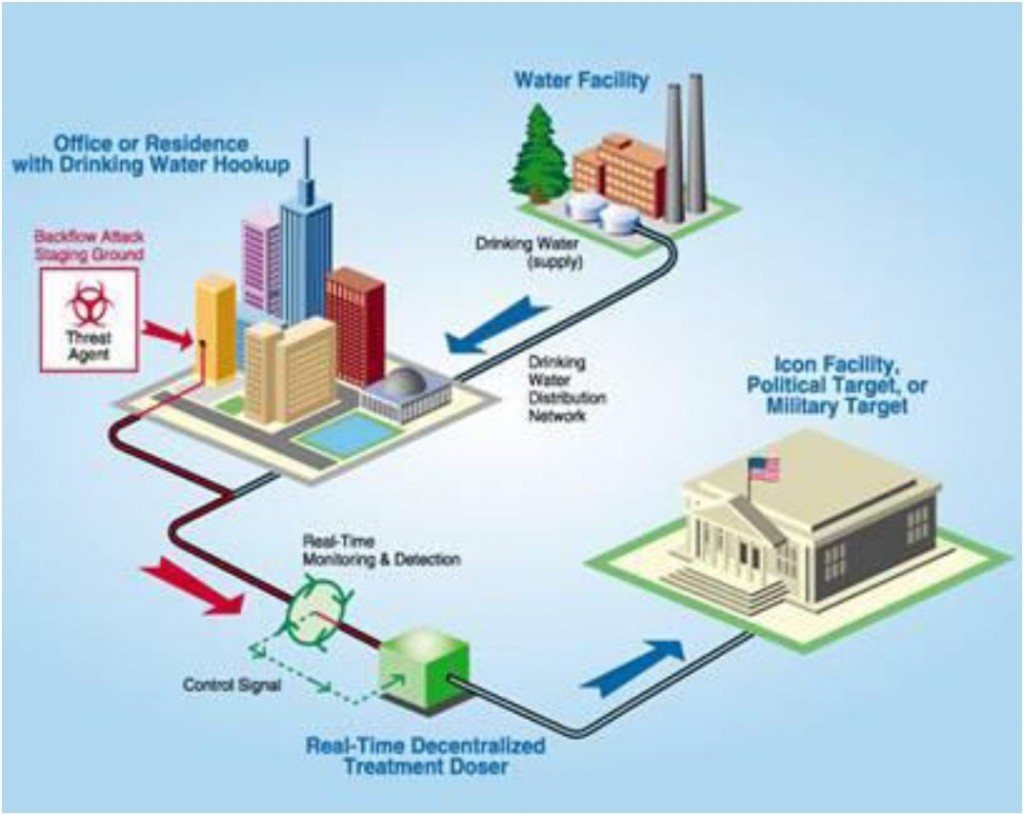The vulnerability of our city water distribution systems to disruption and contamination by potential terrorist or malicious acts has been well documented. These potential attack scenarios have the ability, if orchestrated successfully, to produce casualties on a massive scale.
Studies conducted by personnel at Hach Homeland Security Technologies, Colorado State University and the U.S. Army Corps of Engineers among others have shown that attacks on drinking water supplies could be mounted for between $0.05 and $5.00 per death, using rudimentary techniques, and could amass casualties in the thousands over a period of hours.
The simplest form of attack that could inflict mass casualties would be a simple backflow contamination event. A backflow attack occurs when a pump is used to overcome the water pressure in the distribution system’s pipes. This is usually around 80psi and can be easily achieved by using pumps available for rent or purchase at most home improvement stores.
After a contaminant has been pumped in, a siphoning effects acts to pull the contaminant into the flowing system. Once the contaminant is present in the pipes, the normal movement of water in the system will spread the contaminant throughout the city water system.
The introduction point can be anywhere in the system such as a fire hydrant, commercial building or a home. See figure 1.
Backflows accidents happen on a regular basis and are of great concern to the water industry. Accidental backflow events have been found to be responsible for many incidents of water borne illness and even death in the United States. According to the USEPA, backflow events caused 57 disease outbreaks and 9734 cases of water borne disease between 1981 and 1998.
To prevent such accidental backflows many systems have been equipped with backflow prevention devices. These means of preventing backflow are very useful in preventing these common accidental events. Unfortunately, these physical devices that can be removed or disabled quite easily by a terrorist, rendering them ineffective in preventing deliberate attempts at contamination by all but the most amateurish perpetrators.
Studies conducted by the U.S. Air Force and Colorado State University have shown that a few gallons of highly toxic material, if injected at a strategic location, would contaminate an entire system supplying a population of 100,000 people in a matter of a few hours.
Using computer simulations, when a military nerve agent material was used over 20% of the population was determined to have received a dose adequate to result in death and when a common chemical was used in place of the warfare agent the result was a casualty rate of over 10%.
Thousands of deaths could result from this very inexpensive and low-tech mode of attack. There is no doubt that this form of assault meets all of the terrorist’s criteria for an attack. It would cause mass casualties, be inexpensive, and actually offer the terrorists a good chance of avoiding apprehension.
These sorts of attacks can occur from any access point to the water system. Wherever water can be drawn out, material can be forced back into the system. Some areas, however, are more vulnerable than others. Access points near high flow areas and larger pipes would be favored because they would disseminate the material to a wider area more quickly.
It should be obvious from the large number of accidental backflows that occur and the fact that terrorist organizations have shown an interest in attacking water, the distribution system is a prime candidate for such an attack.
The fact is a bona fide terrorist is virtually inundated by possible candidate substances and locations that would be very effective in such a role. The possibilities are virtually endless. Protecting against and/or detecting such an attack is difficult.
Recent breakthroughs in the online detection of contaminants have made the deployment of a cost effective early warning system capable of detecting and categorizing such events a reality. The simple truth is that these systems are not widely deployed.
This is a re-hash of an article written by Dan Kroll and Katy Craig of Hach Homeland Security Technologies.
1. Kroll,Dan. 2006. Securing Our Water Supply: Protecting a Vulnerable Resource.
PennWell Publishers. Tulsa, Oklahoma.
2. Hickman, Donald C. 1999. A chemical and biological warfare threat: USAF water systems at risk. Counter Proliferation paper No. 3. USAF Counter Proliferation Center, Air War College.
3. Kroll, Dan. 2003. Mass Casualties on a Budget. Confidential Briefing Paper. Hach HST.
4. U.S. Army Corps of Engineers. n.d. Calculations on threat agents and requirements and logistics for mounting a successful backflow attack.
5. Allman, T.P. 2003. Drinking water distribution system modeling for predicting the impact and detection of intentional contamination. Master’s Thesis. Department of Civil Engineering. Colorado State University.
6. USEPA 2002. Potential Contamination Due to Cross-Connections and backflow and the Associated health risks: An Issue Paper.
7. Allman, Timothy and Kenneth Carlson. 2005. Modeling Intentional Distribution System Contamination and Detection. Journal of the American Water Works Association.
January. Note: that the executive summary of this article is still available but the full text has been pulled from the AWWA website for security reasons as it was
determined that the details could be helpful to would be terrorists.
8. EPA. Water Security and You. http://cfpub.epa.gov/safewater/watersecurity/pubs/water-security-article.pdf


